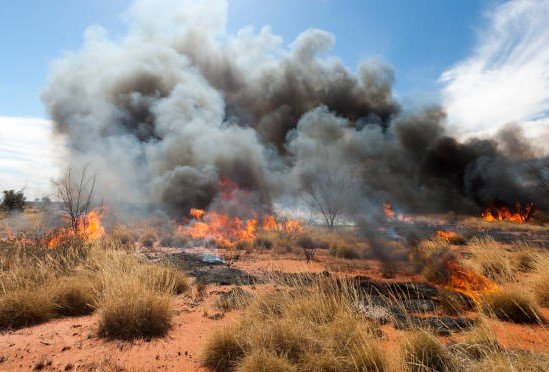A relentless heatwave has slammed eight Arab countries with blistering temperatures and soaring humidity, triggering wildfire alerts and health warnings. From Egypt to Kuwait, citizens are bracing for days of punishing heat that experts say will ease only by late in the week.
The unrelenting sun has pushed thermometers well past 40 degrees Celsius in major cities, while meteorologists warn of dangerous conditions linked to regional weather patterns. Residents are urged to stay cool, hydrated, and alert as authorities prepare for what could be one of the hottest stretches in recent memory.
Heatwaves, Dust Storms, and Wildfire Risks Sweep the Region
In Egypt, the national weather service painted a grim picture for most of the country, especially southern and central Sinai. Winds whipping across these areas stirred up clouds of dust, further reducing air quality and visibility. Greater Cairo is sizzling under temperatures expected to exceed 40°C (104°F), with a heat index—what it actually feels like—topping 43°C (109°F). Meanwhile, Upper Egypt is no relief either, with actual highs reaching a staggering 46°C (115°F) and a heat index close to 47°C (116°F).
Meteorologists trace this blistering heat to a potent cocktail of the Indian monsoon low-pressure system and the Sudan low-pressure system, both funneling swaths of fiery air from the Arabian Peninsula and North Africa directly into the heart of Egypt.

People are being advised to avoid the midday sun, drink plenty of fluids—cold water especially—and keep an eye on vulnerable groups like children and the elderly who are at higher risk of heat-related illnesses.
The heat is expected to slowly taper off starting Saturday, giving the parched region a brief respite after nearly a week of intense conditions.
Across the border in Iraq, conditions are even more severe. The Iraqi Meteorological Organization warned of dust storms compounding the heat in at least nine provinces including Muthanna, Basra, and Karbala. Temperatures are forecast to spike between 49°C and 50°C (120°F to 122°F), with some areas like Muthanna predicted to hit a scorching 51°C (124°F).
Baghdad and surrounding cities Babil, Karbala, Najaf, and Dhi Qar aren’t spared either, with temperatures touching 50°C (122°F). Basra, usually humid, faces highs around 47°C (117°F).
Dust storms pose additional health risks, worsening respiratory problems for many and making travel difficult.
Warnings and Precautions Amid a Growing Climate Challenge
Authorities across the region have issued alerts, urging citizens to take precautions amid the dangerous heat. Hospitals have been put on heightened alert for heatstroke cases, while fire departments brace for an uptick in wildfires, especially in Lebanon, Syria, and Turkey, where dry vegetation and high winds create a volatile environment.
Experts stress the heatwave is more than just a seasonal annoyance. It’s a wake-up call about the accelerating impacts of climate change on the Middle East’s fragile ecosystems and urban centers. The region already battles water shortages and arid conditions; heatwaves this severe strain public health systems and infrastructure.
-
Local governments have ramped up public advisories recommending:
-
Staying indoors during peak heat hours.
-
Using air conditioning or fans.
-
Avoiding strenuous outdoor activity.
-
Checking on neighbors, especially older adults.
-
Keeping pets cool and hydrated.
-
In Bahrain, Qatar, and Kuwait, soaring humidity makes the air feel even hotter than the thermometer reads. The combination of heat and moisture can be deadly, raising the risk of heat exhaustion and dehydration.
Officials have also reminded the public to be vigilant about the increased risk of wildfires. Dry brush and tinderbox conditions across Lebanon and Syria have already led to several fires this week, some of which required emergency evacuations.
What’s Driving This Fierce Heatwave?
The intensity of this heatwave is linked to complex atmospheric patterns. The seasonal Indian monsoon low-pressure system is usually a blessing for much of South Asia, bringing rains and cooler temperatures. However, this year, its interaction with the Sudan low-pressure system has pushed hot desert air northwestward.
This results in a “heat dome” effect where the atmosphere traps warm air near the surface, causing temperatures to soar and remain stubbornly high for days. It’s a phenomenon climate scientists have been tracking closely, as it spells trouble for regions not accustomed to sustained extreme heat.
Forecasts and the Road Ahead
Weather models suggest that while temperatures will remain above normal for most of the week, there will be a gradual easing by Friday or Saturday. Rainfall remains unlikely in the immediate future, meaning drought conditions could worsen, stressing agriculture and water supplies.
| Country | Peak Temp Forecast (°C) | Heat Index (°C) | Notes |
|---|---|---|---|
| Egypt | 46 | 47 | Dust storms in Sinai |
| Iraq | 51 | N/A | Dust storms, severe heat |
| Lebanon | 40+ | High humidity | Wildfire alerts |
| Syria | 42 | High humidity | Wildfire risk |
| Turkey | 38 | Moderate | Heat alerts |
| Bahrain | 41 | Very high | High humidity |
| Qatar | 43 | Very high | Heat and humidity concerns |
| Kuwait | 45 | Very high | Extreme heat warnings |
Citizens across these nations are bracing for what many say is one of the harshest heat spells in recent years.
While the weather agencies urge calm and caution, this event serves as a stark reminder: climate change’s fingerprints are all over these extreme weather events, making preparation and adaptation more urgent than ever.
